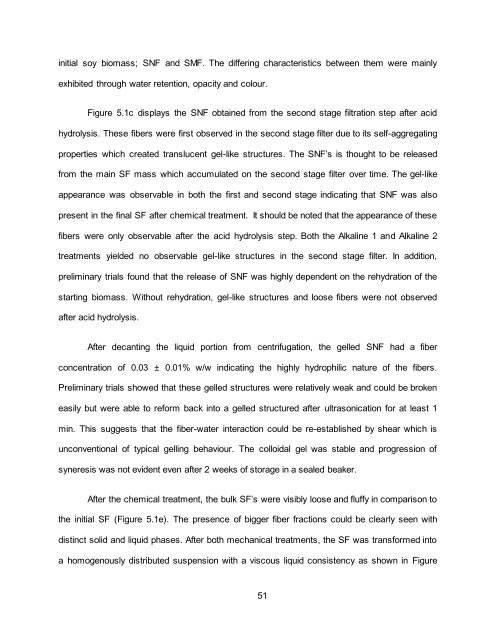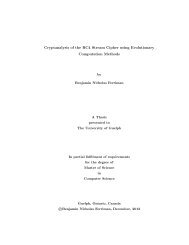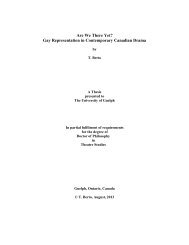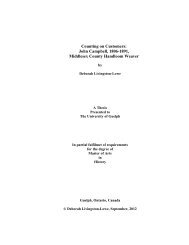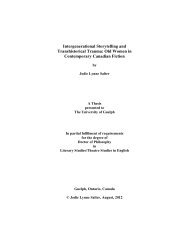THESIS - ROC CH ... - FINAL - resubmission.pdf - University of Guelph
THESIS - ROC CH ... - FINAL - resubmission.pdf - University of Guelph
THESIS - ROC CH ... - FINAL - resubmission.pdf - University of Guelph
Create successful ePaper yourself
Turn your PDF publications into a flip-book with our unique Google optimized e-Paper software.
initial soy biomass; SNF and SMF. The differing characteristics between them were mainly<br />
exhibited through water retention, opacity and colour.<br />
Figure 5.1c displays the SNF obtained from the second stage filtration step after acid<br />
hydrolysis. These fibers were first observed in the second stage filter due to its self-aggregating<br />
properties which created translucent gel-like structures. The SNF’s is thought to be released<br />
from the main SF mass which accumulated on the second stage filter over time. The gel-like<br />
appearance was observable in both the first and second stage indicating that SNF was also<br />
present in the final SF after chemical treatment. It should be noted that the appearance <strong>of</strong> these<br />
fibers were only observable after the acid hydrolysis step. Both the Alkaline 1 and Alkaline 2<br />
treatments yielded no observable gel-like structures in the second stage filter. In addition,<br />
preliminary trials found that the release <strong>of</strong> SNF was highly dependent on the rehydration <strong>of</strong> the<br />
starting biomass. Without rehydration, gel-like structures and loose fibers were not observed<br />
after acid hydrolysis.<br />
After decanting the liquid portion from centrifugation, the gelled SNF had a fiber<br />
concentration <strong>of</strong> 0.03 ± 0.01% w/w indicating the highly hydrophilic nature <strong>of</strong> the fibers.<br />
Preliminary trials showed that these gelled structures were relatively weak and could be broken<br />
easily but were able to reform back into a gelled structured after ultrasonication for at least 1<br />
min. This suggests that the fiber-water interaction could be re-established by shear which is<br />
unconventional <strong>of</strong> typical gelling behaviour. The colloidal gel was stable and progression <strong>of</strong><br />
syneresis was not evident even after 2 weeks <strong>of</strong> storage in a sealed beaker.<br />
After the chemical treatment, the bulk SF’s were visibly loose and fluffy in comparison to<br />
the initial SF (Figure 5.1e). The presence <strong>of</strong> bigger fiber fractions could be clearly seen with<br />
distinct solid and liquid phases. After both mechanical treatments, the SF was transformed into<br />
a homogenously distributed suspension with a viscous liquid consistency as shown in Figure<br />
51


